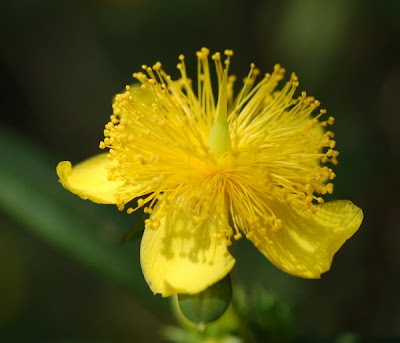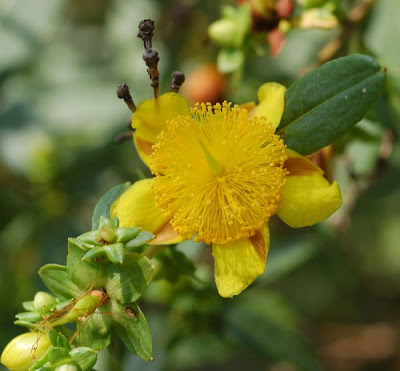
The St. John's Wort has been in bloom the last couple of weeks. They're small but beautiful flowers. Don't you love that cloud of anthers? Ours is a woody shrub, and it's abundant around the locust and hawthorn thickets overtaking the old field on top of our ridge.
I wasn't sure what species we have, so I turned to the incredibly frustrating but essential Flora of West Virginia (Strausbaugh and Core, WVU Press, Revised Edition, 1970). I know St. John's Wort on sight--it's genus is Hypericum. The Flora of West Virginia has no index, so the only way to find it in the book is through the key to families at the front of Volume 1. I skip to the Dicots couplet, 35. Yup, "Polypetalous plants," sends me to couplet 78, "Stamens numerous, usually more than 10." As a well-brought-up taxonomist, I pause to curse the use of "usually" in a key to families. However, I know we have WAY more than 10 stamens, so I continue to couplet 79--"Calyx free from ovary" vs. "Calyx more or less jointed to the ovary." "MORE OR LESS!" I snort. I know the answer, (the calyx is definitely free) but I can see I'm down to a short list of families, so I start skimming. There's Guttiferae, one of Linnaeus' eight conserved family names, venerable designations like Graminae that are kept even though they don't consist of a genus-name root plus the "aceae" family ending. Modern botanists scorn the conserved names, and call the St. John's Wort family either Hypericaceae (splitters) or Clusiaceae (lumpers, who put Hypericum in the Mangosteen family).
There it is in the Flora of West Virginia, Family Guttiferae, page 630. Now, I know page 630 is in Volume 3, so I pick up volume 3, turn to page 630, which is Family Tiliaceae, the Basswood family. The pages are misnumbered in the key, so I start leafing forward and backward. Guttiferae is on page 638. (I turn to the Guttiferae couplet in the Key to Families, and pencil in the correct number. In a few years, I will have a useful Key to Families.)
There I read that there are 12 species of St. John's Wort in West Virginia, and learn that
The common name St. John's Wort alludes to the flowering of many of the plants about St. John the Baptist's Day (June 24).The key to species works nicely, and sends me to a couplet giving me a choice between Hypericum prolificum and Hypericum densiflorum. The two species are distinguished from one another by the size of the seed capsule. Although size of seed capsule can vary due to environmental factors, I'm reasonably comfortable offering an identification of Hypericum prolificum--"Shrubby St. John's Wort." I was surprised that this common shrub of old pastures and roadsides is not the introduced Palearctic St. John's Wort, but a native species that is uncommon in some parts of its range.
Some Web references for Hypericum species:
- USDA's Plants Database entry for Hypericum prolificum..
- Hypericum prolificum. from Wisconsin's Robert W. Freckmann Herbarium.
- UConn Plant Database entry for Hypericum prolificum.
- USDA's Plants Database entry for Hypericum densiflorum.
- Hypericum densiflorum entry from US Fish and Wildlife Service's Native Plants for Wildlife Habitat and Conservation Landscaping: Chesapeake Bay Watershed.
- USDA's Plants Database entry for Hypericum perforatum..
- St. John's Wort from the "Herbs at a Glance" section of NIH's National Center for Complimentary and Alternative Medicine (NCCAM). They are talking about Hypericum perforatum, the Old World species that's a common exotic in North America.
- Cornell's Animal Science Department has a page on Hypericism, extreme photosensitivity in livestock, caused by ingestion of St. John's Wort.
- Arthur C. Gibson's essay on St. John's Wort observes that St. John's wort, like a fairy, supposedly protects against evil beings, chases demons, and can silence poltergeists (see A. R. Vickery, "Traditional uses and folklore of Hypericum in the British Isles," Economic Botany 35:289-295, 1981).

2 comments:
An interesting account of keying out a species. Imprecisions in taxonomic keys, which are human artifacts and subject to human fallibility, can indeed be frustrating!
Off-topic, but this morning I read an of interesting island population of katydids in your county. The first link in this page is to a PDF file by RD Alexander, an excerpt from "Singing Insects". On the off-chance that you haven't already seen this, here's the link:
http://buzz.ifas.ufl.edu/s131a.htm
Larry, thanks for this link. I'm still trying to figure out the localities Alexander was referring to (Droop Mountain Battlefield State Park is in Pocahontas County, not Greenbrier)--when he says "south of Droop Mountain" does he mean the park, or the mountain? I'll probably spend hours wandering around now, listening for katydids.
Post a Comment